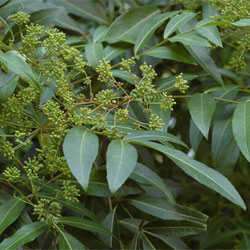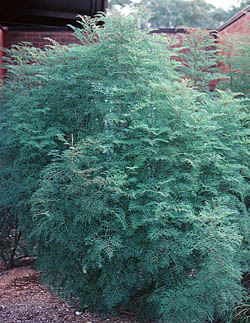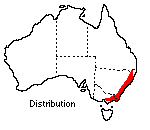Polyscias sambucifolia
 broad-leaf form |
 fine-leaf form |
Elderberry Panax
Polyscias sambucifolia (Sieber ex DC.) Harms
The graceful Polyscias sambucifolia, commonly known as Elderberry Panax and a member of the Araliaceae family, is a very variable shrub to 3 m or more. It is found in forested coastal to sub-alpine regions in New South Wales, Victoria, the Australian Capital Territory and Queensland that receive 600-900 mm rainfall.
 At
least three distinct forms of P. sambucifolia occur. The tallest is generally
a fine compound-leaved shrub of spreading and upright habit usually found in
coastal areas. Coarser, broader-leaved forms may be found in mountains and coastal
regions. In sub-alpine habitats, leaves may be intermediate in size, grey-green
and paler beneath. The sub-alpine shrubs may reach a height of less than 2 m,
with a tendency to sucker.
At
least three distinct forms of P. sambucifolia occur. The tallest is generally
a fine compound-leaved shrub of spreading and upright habit usually found in
coastal areas. Coarser, broader-leaved forms may be found in mountains and coastal
regions. In sub-alpine habitats, leaves may be intermediate in size, grey-green
and paler beneath. The sub-alpine shrubs may reach a height of less than 2 m,
with a tendency to sucker.
The leaves of P. sambucifolia are pinnate or bipinnate with individual leaflets opposite and toothed or toothed only in juvenile foliage. Leaf and width are very variable. The finer leaved forms may be linear and 20-40 mm by 2-3 mm. Those with broader leaves may have oblong acute leaflets 30-130 mm by 10-50 mm. Intermediate forms also exist, making it difficult to recognise this species in the wild.
Polyscias sambucifolia is an attractive foliage plant which produces blue-grey succulent fruit in summer. The flowers, although borne in large sprays from September to December, are pale green and insignificant. It is well suited to cool moist gardens and the suckering habit of the alpine form may be useful in producing a dense screen-like effect. This growth could easily be controlled if desired. Lateral branching is usually to ground level, producing a 'bushy' shrub.
Propagation is by cuttings or seed. To reproduce selected forms cuttings should be taken in summer to autumn.
The attractive dense foliage and summer fruit, the excellent tolerance of some forms to cold conditions and the ability to grow in all but very sandy soils make this relatively unknown native plant one to be recommended for garden use provided that it receives adequate water.
The fine-leaved coastal form may have some applications as an indoor plant.
Text by Barrie Hadlow, ANBG (1983)
Name meaning: Polyscias sambucifoliaPolyscias - from the Greek words, poly, meaning many, and skias, meaning shade, possibly referring to the shade from many leaves; sambucifolia - referring to leaves which resemble those of Sambucus, the Elderberry. |
![An Australian Government Initiative [logo]](/images/austgovt_brown_90px.gif)

